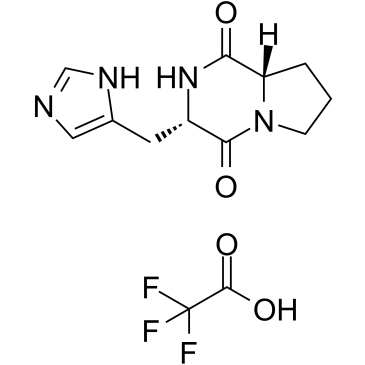Cyclo(his-pro) TFA
Modify Date: 2025-09-23 13:48:16

Cyclo(his-pro) TFA structure
|
Common Name | Cyclo(his-pro) TFA | ||
|---|---|---|---|---|
| CAS Number | 936749-56-3 | Molecular Weight | 348.28 | |
| Density | N/A | Boiling Point | N/A | |
| Molecular Formula | C13H15F3N4O4 | Melting Point | N/A | |
| MSDS | N/A | Flash Point | N/A | |
Use of Cyclo(his-pro) TFACyclo(his-pro) TFA (Cyclo(histidyl-proline) TFA) is an orally active cyclic dipeptide structurally related to tyreotropin-releasing hormone[1]. Cyclo(his-pro) TFA could inhibit NF-κB nuclear accumulation. Cyclo(his-pro) TFA can cross the brain-blood-barrier and affect diverse inflammatory and stress responses[2]. |
| Name | Cyclo(his-pro) TFA |
|---|
| Description | Cyclo(his-pro) TFA (Cyclo(histidyl-proline) TFA) is an orally active cyclic dipeptide structurally related to tyreotropin-releasing hormone[1]. Cyclo(his-pro) TFA could inhibit NF-κB nuclear accumulation. Cyclo(his-pro) TFA can cross the brain-blood-barrier and affect diverse inflammatory and stress responses[2]. |
|---|---|
| Related Catalog | |
| Target |
NF-κB Human Endogenous Metabolite |
| In Vitro | Cyclo(his-pro) TFA (Cyclo(histidyl-proline) TFA; 50 μM; 1-48 hours) increases the nuclear level of Nrf2 and inhibits NF-κB nuclear translocation. Cyclo(His-Pro) alone has no effect on nuclear translocation of these transcription factors[2]. Cyclo(his-pro) TFA (50 μM; prior to PQ exposure for 48 hours) abolishes protein nitration that followed paraquat (PQ) exposure and lessenes its functional consequences, as shown by decrease in cell apoptosis, detected by caspase 3 activity and by cytochrome c release[2]. Cyclo(his-pro) TFA inhibits NF-κB nuclear accumulation induced by paraquat in rat pheochromocytoma PC12 cells via the Nrf2/heme oxygenase-1 pathway[2]. Western Blot Analysis[1] Cell Line: PC12 cells Concentration: 50 μM Incubation Time: 1, 2, 4, 8, 24, 48 hours Result: Increased the nuclear level of Nrf2 and inhibited NF-κB nuclear translocation. |
| In Vivo | Cyclo(his-pro) TFA (Cyclo(histidyl-proline) TFA; 1.8 mg/ear; topical application on the right ear; 30 min prior to TPA) reduces TPA-induced ear oedema confirming that it can exert anti-inflammatory effect[2]. Cyclo(his-pro) TFA exerts in vivo anti-inflammatory effects in the central nervous system by down-regulating hepatic and cerebral TNFα expression thereby counteracting LPS-induced gliosis. Moreover, by up-regulating Bip, Cyclo(his-pro) increases the ER stress sensitivity andtriggers the unfolded protein response to alleviate the ER stress[3]. Animal Model: Sixty two/three month-old male C57BL/6 mice (25-30 g) [2] Dosage: 1.8 mg/ear Administration: Topical application on the right ear; 30 min prior to TPA Result: Reduced TPA-induced ear oedema. |
| References |
| Molecular Formula | C13H15F3N4O4 |
|---|---|
| Molecular Weight | 348.28 |
| InChIKey | YOFCDSUBRJNLBB-OZZZDHQUSA-N |
| SMILES | O=C(O)C(F)(F)F.O=C1NC(Cc2cnc[nH]2)C(=O)N2CCCC12 |